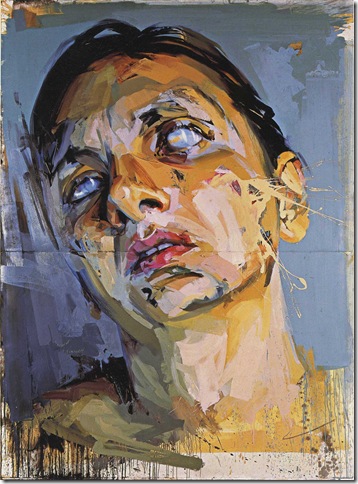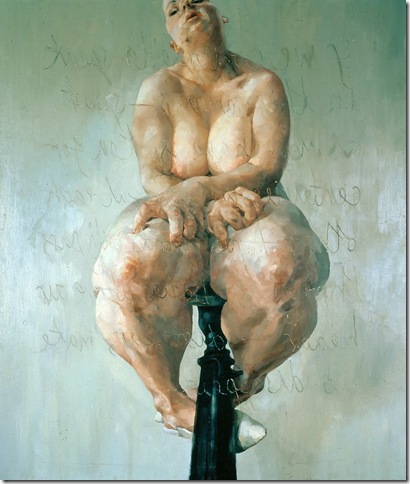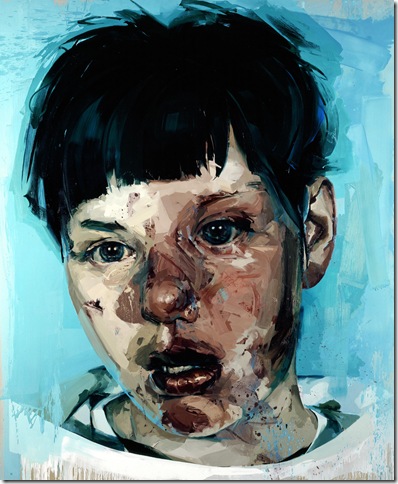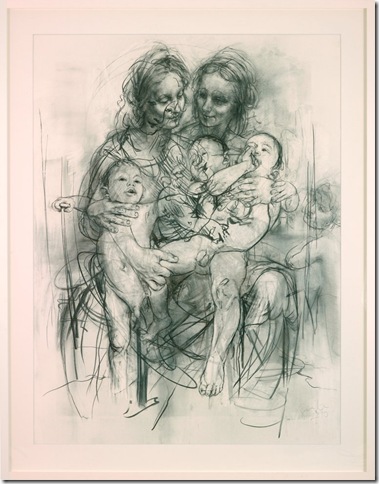A survey of British painter Jenny Saville is on view at the Norton Museum of Art in West Palm Beach until March 4. Included in the exhibit are 15 of the artist’s large-scale oil paintings and 15 of her drawings.
This is the artist’s first solo in a museum in the United States, though she did have a one-woman gallery exhibit at the Gagosian Gallery in 1999. Other than this, Saville’s only solo exhibitions have been in London and Italy.
Cheryl Brutvan, the Norton’s curator of contemporary art was able to identify and secure Saville’s work because of a generous grant provided by the Leonard and Sophie Davis Fund/MLDauray Arts Initiative. The grant funds a series referred to as “RAW: Recognition of Art by Women,” which will bring the work of six contemporary female artists’ work to the Norton over the course of the next six years.
It seems fitting that Jenny Saville was chosen as the first artist for RAW because “raw” is also an apt description of her work. Her paintings are large. Her subjects are people and her style is figurative. However, she doesn’t idealize them in a traditional way. Instead, she portrays a human form that is fleshy, obese, bruised, and disfigured. Yet, she evokes from these malformed figures inherent beauty. Her work has many layers of feminist nuance.
In Propped (1992) an obese woman sits precariously atop a stool that she’s evidently much too large for. Her nudity rebels against the “male gaze” and somehow there’s beauty in her repugnant fatness. The work demonstrates Saville’s natural talent as a painter. She was only 22 when she created this work. The subject’s stare is provocative. This type of stare is a repetitive theme throughout Saville’s oeuvre. Her color choices allude to Lucien Freud and Francis Bacon, both of whom she counts amongst influencers.
Brutvan explained it this way: “She paints flesh and so she uses the tones that we find in the white body. She really looks at the color. I don’t think her work is idealized or romanticized at all. It’s very much reality. There’s a certain tone, but it’s full of color. You look at the fulcrum and it’s just an amazing passage to create that subtlety of the feeling of flesh.”
Saville is a young artist. She was born in 1970 in England, received her B.A. in fine art, with honors, from the Glasgow School of Art in 1992 and was discovered that same year by the iconic British art collector Charles Saatchi.
Saatchi commissioned her to create new work for a gallery show the following year and subsequently extended the commission for a period of three additional years.
“She’s an artist that became very well known very young — when she was still in her 20s. She had work exhibited publically and then a newspaper put her painting on the cover of their Sunday section,” Brutvan said. “Charles Saatchi saw that reproduction and pursued buying her work and then getting his hands on everything that was produced, even though it was her graduate show.”
As a result of her affiliation with Saatchi, her work was included in the notorious “Sensation” show of work from his collection, which travelled to the Brooklyn Museum in 1999, and also included work by Damien Hirst and Tracey Emin. At this point she met Larry Gagosian, who became her U.S. dealer.
Three subsequent life events shaped her future work. The first is that she received a residency in Connecticut that allowed her to study medical libraries and observe a local plastic surgeon. She embraced this opportunity because she saw it as a way to better understand human anatomy. She could now see behind the flesh, which already fascinated her. “The first face lift I saw was absolutely amazing because the doctor literally pulled the face off and then — it was a deep-tissue one — you could see how thick the flesh was,” Saville has said.
One wonders if Isis (2011), whose body seems marked into segments, awaits plastic surgery. She appears pathetically vulnerable, as though she’s looking to the viewer for approval, and this evokes sympathy. Soon, she’ll be cut through, like raw steak, in a quest for beauty. Apparently, the idea of flesh as an object apart from the person inhabiting it was compelling for Saville even as a child.
“Her mother remembers she was interested in, or didn’t mind the appearance of, liver that was being prepared to eat. She had openness to that kind of reality – to flesh and blood and doesn’t shy away from images that other people might find more difficult,” Brutvan said.
The second major life event to shape her work was her becoming a part-time resident of Palermo in Sicily. She bought a dilapidated 18th-century palazzo and began to divide her time between there and London. Palermo had a profound effect on her. It’s a city of striking contrasts, where buildings decimated by war remain unaltered, yet subliminal natural beauty abounds.
One of the most engaging works in the exhibit is Rosetta (2005-2006), which she created in Palermo and is the portrait of a blind woman that Saville found beautiful. “Her eyes are like globes, planetary systems,” the painter said. Rosetta was emblematic of Italy’s gritty authenticity, which appealed to Saville.
“Things were more real and authentic than in a city like London. And that feeds into what she’s interested in with her own artistic process and subject, and what you learn by layers coming forward and how that informs the next move you’re going to make within a composition,” Brutvan said. “What she saw in Palermo was a manifestation of the ideas she already had as an artist.”
The other major life event that influenced her recent work is that she became a mother. In 2007, she gave birth to a son, and the following year a daughter. Shortly after this, in 2009, she began a series of charcoal drawings that are based on Leonardo da Vinci’s work, The Virgin and Child with Saint Anne and Saint John the Baptist, which is found in London’s National Gallery.
Her depictions of motherhood, as with all her work, are not entirely idealized. At times, the figures seem strained and awkward — yet the women’s faces do possess a marked serenity. Her skill as a draftsman shines through in these drawings where her raw talent is most visible.
There’s a tinge of irony to the Jenny Saville exhibition — with its provocative, feminist underpinnings — that’s noteworthy. Mounted in a plastic-surgery-and-appearance-obsessed locale like Palm Beach, probably one of the most image-conscious areas in the country, the exhibit will surely draw the ‘ladies who lunch” crowd.
Momentarily imagining these types of women strolling through the show after lunching at the Norton’s café, makes one want to be a fly on the wall to overhear their comments — and adds another layer of nuance to this thought-provoking show.
Jenifer Mangione Vogt is a marketing communications professional and resident of Boca Raton. She studied art history and received her B.A. from Purchase College. Visit her blog at www.fineartnotebook.com
***
Jenny Saville is on view at the Norton Museum of Art until March 4. Hours for this exhibition are Tuesday, Wednesday, Friday and Saturday from 10 a.m. until 5 p.m., Thursdays from 10 a.m. until 9 p.m., and Sunday from 1 p.m. until 5 p.m. Admission is $12 for adults, $5 for visitors aged 2 through 13, and free for children under 13. Palm Beach County residents receive free museum admission on the first Saturday of each month. For more information call 832-5196, or visit www.norton.org.



